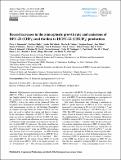Recent increases in the atmospheric growth rate and emissions of HFC-23 (CHF₃) and the link to HCFC-22 (CHClF₂) production
Author(s)
Simmonds, Peter G.; Rigby, Matthew; McCulloch, Archie; Vollmer, Martin K.; Henne, Stephan; Mühle, Jens; O'Doherty, Simon; Manning, Alistair J.; Krummel, Paul B.; Fraser, Paul J.; Young, Dickon; Weiss, Ray F.; Salameh, Peter K.; Harth, Christina M.; Reimann, Stefan; Trudinger, Cathy M.; Steele, L. Paul; Wang, Ray H. J.; Mitrevski, Blagoj; Etheridge, David M.; Ivy, Diane J; Prinn, Ronald G; ... Show more Show less
Downloadacp-18-4153-2018.pdf (3.514Mb)
PUBLISHER_CC
Publisher with Creative Commons License
Creative Commons Attribution
Terms of use
Metadata
Show full item recordAbstract
High frequency measurements of trifluoromethane (HFC-23, CHF₃), a potent hydrofluorocarbon greenhouse gas, largely emitted to the atmosphere as a by-product of the production of the hydrochlorofluorocarbon HCFC-22 (CHClF₂), at five core stations of the Advanced Global Atmospheric Gases Experiment (AGAGE) network, combined with measurements on firn air, old Northern Hemisphere air samples and Cape Grim Air Archive (CGAA) air samples, are used to explore the current and historic changes in the atmospheric abundance of HFC-23. These measurements are used in combination with the AGAGE 2-D atmospheric 12-box model and a Bayesian inversion methodology to determine model atmospheric mole fractions and the history of global HFC-23 emissions. The global modelled annual mole fraction of HFC-23 in the background atmosphere was 28.9 ± 0.6 pmolmol⁻¹ at the end of 2016, representing a 28% increase from 22.6 ± 0.4 pmolmol⁻¹ in 2009. Over the same time frame, the modelled mole fraction of HCFC-22 increased by 19% from 199 ± 2 to 237 ± 2 pmolmol⁻¹. However, unlike HFC-23, the annual average HCFC-22 growth rate slowed from 2009 to 2016 at an annual average rate of -0.5 pmolmol⁻¹yr⁻². This slowing atmospheric growth is consistent with HCFC-22 moving from dispersive (high fractional emissions) to feedstock (low fractional emissions) uses, with HFC-23 emissions remaining as a consequence of incomplete mitigation from all HCFC-22 production. Our results demonstrate that, following a minimum in HFC-23 global emissions in 2009 of 9.6±0.6, emissions increased to a maximum in 2014 of 14.5±0.6Gg yr⁻¹ and then declined to 12.7±0.6Gg yr⁻¹(157±MtCO2eq.yr⁻¹) in 2016. The 2009 emissions minimum is consistent with estimates based on national reports and is likely a response to the implementation of the Clean Development Mechanism (CDM) to mitigate HFC-23 emissions by incineration in developing (non-Annex 1) countries under the Kyoto Protocol. Our derived cumulative emissions of HFC-23 during 2010-2016 were 89 ± 2Gg (1.1±0.2GtCO₂eq.), which led to an increase in radiative forcing of 1.0g0.1gmWgmg&2 over the same period. Although the CDM had reduced global HFC-23 emissions, it cannot now offset the higher emissions from increasing HCFC-22 production in non-Annex 1 countries, as the CDM was closed to new entrants in 2009. We also find that the cumulative European HFC-23 emissions from 2010 to 2016 were ~ 1.3 Gg, corresponding to just 1.5g% of cumulative global HFC-23 emissions over this same period. The majority of the increase in global HFC-23 emissions since 2010 is attributed to a delay in the adoption of mitigation technologies, predominantly in China and East Asia. However, a reduction in emissions is anticipated, when the Kigali 2016 amendment to the Montreal Protocol, requiring HCFC and HFC production facilities to introduce destruction of HFC-23, is fully implemented.
Date issued
2018-03Department
Massachusetts Institute of Technology. Center for Global Change ScienceJournal
Atmospheric Chemistry and Physics
Publisher
Copernicus GmbH
Citation
Simmonds, Peter G. et al. “Recent increases in the atmospheric growth rate and emissions of HFC-23 (CHF₃) and the link to HCFC-22 (CHClF₂) production.” Atmospheric Chemistry and Physics 18, 6 (March 2018): 4153–4169 © 2018 Author(s)
Version: Final published version
ISSN
1680-7324
1680-7316